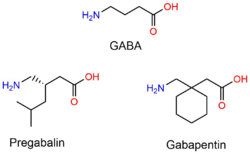Gabapentinoids: Difference between revisions
>Tracer m Added Baclofen |
>Unity Cleaned up and expanded. |
||
| Line 1: | Line 1: | ||
{{Stub}} | {{Stub}} | ||
[[File:Gabapentinoidsstructure.png|250px|thumbnail|Diagram showing the structural similarities of [[GABA|gamma-aminobutyric acid]] (GABA), [[pregabalin]] and [[gabapentin]].]] | [[File:Gabapentinoidsstructure.png|250px|thumbnail|Diagram showing the structural similarities of [[GABA|gamma-aminobutyric acid]] (GABA), [[pregabalin]] and [[gabapentin]].]] | ||
Gabapentinoids are | '''Gabapentinoids''' are a chemical class of [[psychoactive substances]] derived from [[GABA|gamma-aminobutyric acid]] (GABA).{{citation needed}} Members of this class include [[gabapentin]], [[F-phenibut]], [[phenibut]], [[baclofen]] and [[pregabalin]]. | ||
=See also= | |||
Gabapentinoids are commonly prescribed for epilepsy, neuropathic pain, and [[restless legs syndrome]]. [[Subjective effects]] include [[sedation]], [[muscle relaxation]], and [[anxiety suppression]]. | |||
Gabapentinoids can be dangerous when mixed with other [[depressants]] such as [[benzodiazepines]], [[alcohol]] and [[opioids]]. | |||
==Chemistry== | |||
Gabapentinoids are 3-substituted derivatives of GABA. Hence, they are GABA analogues, as well as γ-amino acids.<ref>Elaine Wyllie; Gregory D. Cascino; Barry E. Gidal; Howard P. Goodkin (17 February 2012). Wyllie's Treatment of Epilepsy: Principles and Practice. Lippincott Williams & Wilkins. p. 423. ISBN 978-1-4511-5348-4.</ref><ref>Honorio Benzon; James P. Rathmell; Christopher L. Wu; Dennis C. Turk; Charles E. Argoff; Robert W Hurley (11 September 2013). Practical Management of Pain. Elsevier Health Sciences. p. 1006. ISBN 978-0-323-17080-2.</ref> | |||
==Pharmacology== | |||
Gabapentinoids act by blocking α2δ subunit-containing voltage-dependent calcium [[receptor#Ion_channels|channels]] (VGCCs).{{citation needed}} While all gabapentinoids block the α2δ channels, they also have unique pharmacological characteristics such as enzyme inhibition.{{citation needed}} | |||
==Examples== | |||
*[[Baclofen]] | |||
*[[F-Phenibut]] | |||
*[[Gabapentin]] | |||
*[[Phenibut]] | |||
*[[Pregabalin]] | |||
==See also== | |||
*[[Responsible use]] | *[[Responsible use]] | ||
*[[Depressants]] | *[[Depressants]] | ||
| Line 14: | Line 31: | ||
*[https://en.wikipedia.org/wiki/Gabapentinoid Gabapentinoid (Wikipedia)] | *[https://en.wikipedia.org/wiki/Gabapentinoid Gabapentinoid (Wikipedia)] | ||
[[Category:Gabapentinoid]] | ==References== | ||
[[Category:Gabapentinoid]][[Category:Chemical class]] | |||
Revision as of 17:52, 25 April 2019
 |
This article is a stub. As such, it may contain incomplete or wrong information. You can help by expanding it. |

Gabapentinoids are a chemical class of psychoactive substances derived from gamma-aminobutyric acid (GABA).[citation needed] Members of this class include gabapentin, F-phenibut, phenibut, baclofen and pregabalin.
Gabapentinoids are commonly prescribed for epilepsy, neuropathic pain, and restless legs syndrome. Subjective effects include sedation, muscle relaxation, and anxiety suppression.
Gabapentinoids can be dangerous when mixed with other depressants such as benzodiazepines, alcohol and opioids.
Chemistry
Gabapentinoids are 3-substituted derivatives of GABA. Hence, they are GABA analogues, as well as γ-amino acids.[1][2]
Pharmacology
Gabapentinoids act by blocking α2δ subunit-containing voltage-dependent calcium channels (VGCCs).[citation needed] While all gabapentinoids block the α2δ channels, they also have unique pharmacological characteristics such as enzyme inhibition.[citation needed]
Examples
See also
External links
References
- ↑ Elaine Wyllie; Gregory D. Cascino; Barry E. Gidal; Howard P. Goodkin (17 February 2012). Wyllie's Treatment of Epilepsy: Principles and Practice. Lippincott Williams & Wilkins. p. 423. ISBN 978-1-4511-5348-4.
- ↑ Honorio Benzon; James P. Rathmell; Christopher L. Wu; Dennis C. Turk; Charles E. Argoff; Robert W Hurley (11 September 2013). Practical Management of Pain. Elsevier Health Sciences. p. 1006. ISBN 978-0-323-17080-2.